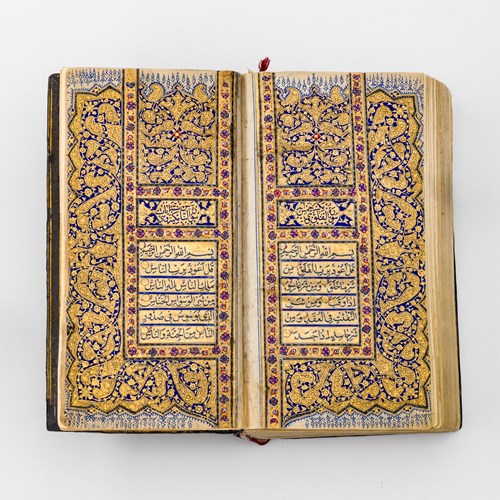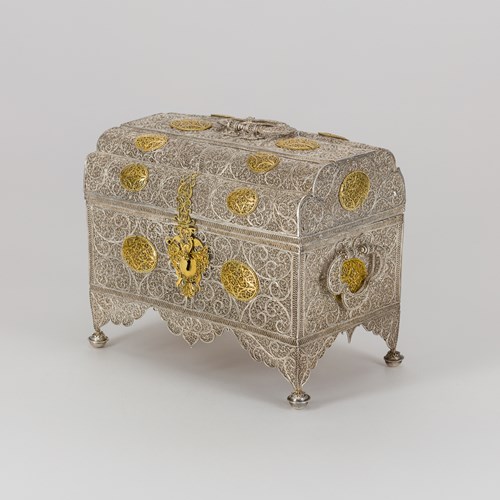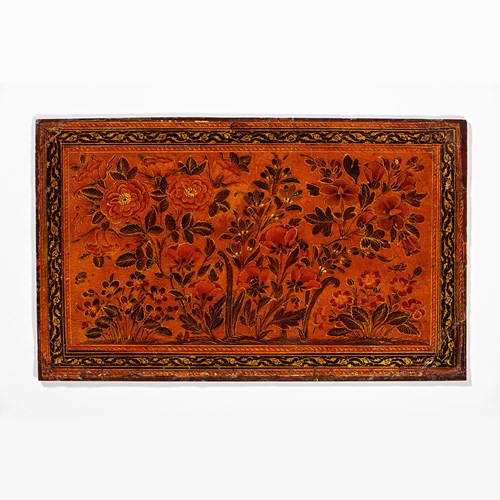Writing Cabinet
Date Early 17th century
Period 1600-1750, 17th century
Origin South China
Medium Carved, ebonised, lacquered, gilded wood
Dimension 40.5 x 57 x 40 cm (16 x 22¹/₂ x 15³/₄ inches)
This writing box belongs to a rare group of objects - some with inscriptions in Chinese such as this one - which have been recently studied and exhibited (see Crespo, 2016, pp. 288-303, Cat. No. 25 for a very similar example; and Jordan Gschwend and Lowe, 2017, pp. 226-27, Cat. No. 249). The production of these pieces of furniture, modelled after contemporary European prototypes is almost certainly linked with commissions from Portuguese noblemen and rich merchants living in Asia, namely in the south coastal regions of the Guangdong, Fujian and Zhejiang provinces (see Krahl, 2007; Crespo, 2015). Some documented examples may be found in the inventory drawn up in 1570, of the estate left by Simão de Melo Magalhães, Captain of Malacca from 1545 to 1548, between his widow and children: one writing cabinet with silver mountings and also its lock with gilded drawers and silver pullers (12,000 reais); one gilded writing cabinet from China (1,000 reais); and one old casket from China painted in red and gold (200 reais). These were certainly embellished with either Chinese decorative schemes and repertoire or with Renaissance motifs and compositions copied from European prints - such as our writing cabinet - all in gold leaf set on a black or red lacquered ground. The origin and style of such pieces is clear, mainly in the examples that show a typical and unmistakably Chinese decorative repertoire, such as the so-called "Cardinal Albert's" table top (Kunsthistorisches Museum, Vienna, Acc. No. 4958), or the so-called "Pope's Chest" (Museum für Angewandte Kunst / Gegenwartskunst, Vienna, Acc. No. MD047590).
Date: Early 17th century
Period: 1600-1750, 17th century
Origin: South China
Medium: Carved, ebonised, lacquered, gilded wood
Dimension: 40.5 x 57 x 40 cm (16 x 22¹/₂ x 15³/₄ inches)
Provenance: Private European Collection
Literature: Crespo, H.M. "Global Interiors on the Rua Nova in Renaissance Lisbon", in Annemarie Jordan Gschwend, K. J. P. Lowe (eds.), The Global City. On the Streets of Renaissance Lisbon, London, Paul Holberton publishing, 2015, pp. 121-39.
Crespo, H.M. Choices, Lisboa, AR-PAB, 2016.
Gschwend, A.J. and K. J. P. Lowe (eds.). A Cidade Global. Lisboa no Renascimento. The Global City. Lisbon in the Renaissance (exh. cat.), Lisboa, Museu Nacional de Arte Antiga, 2017.
Krahl, R. "The Portuguese Presence in the Arts and Crafts of China", in Jay A. Levenson (ed.), Encompassing the Globe. Portugal and the World in the 16th and 17th Centuries (cat.), Vol. 3, Washington, Smithsonian Institution, 2007, pp. 235-41.
Welch, P.B. Chinese Art. A Guide to Motifs and Visual Imagery, Tokyo - Rutland - Singapore, Tuttle, 2008.
More artworks from the Gallery









